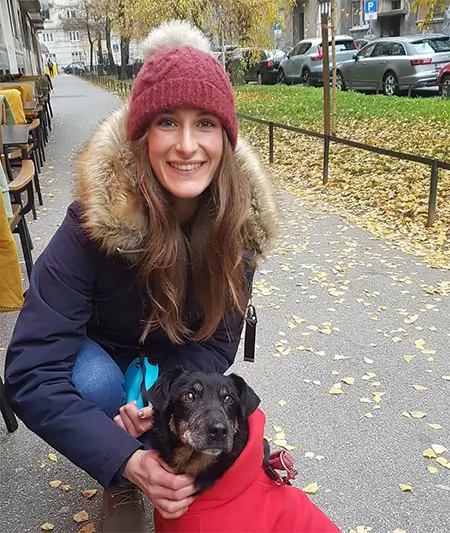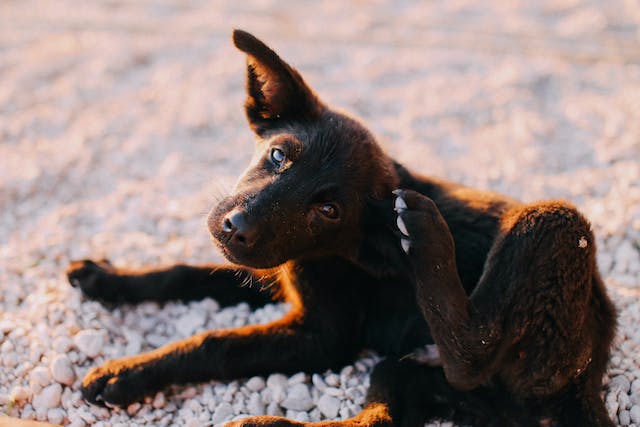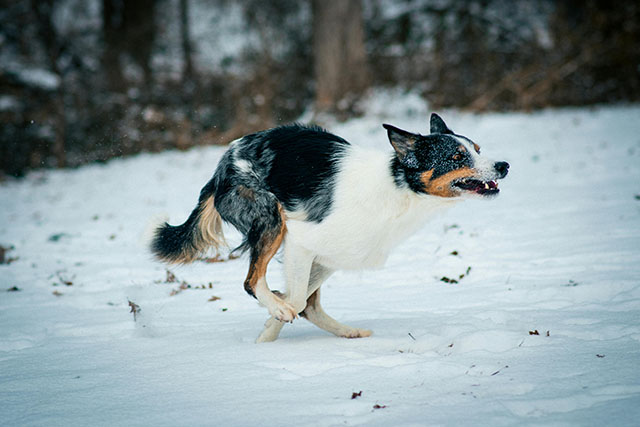Dogs can suffer from allergies just like us humans, although they often show them in ways we don’t expect. Food allergies in dogs often cause changes in the skin and can be pretty complicated to manage.
But don’t worry, in this article, we’ll explain how you can help a dog with a food allergy by answering the following questions:
- How do I know if my dog has food allergies?
- What is an elimination diet trial?
- What food is best for a dog with skin allergies?
- Are there other ways to help a dog with a food allergy?
Disclaimer: Please refer to the information in this article as a guide only. If you think your dog may have allergies, it’s best to contact your veterinarian for proper diagnosis and treatment.
How do I know if my dog has food allergies?
It may seem strange, but food allergies in dogs often affect their skin and or ears. Itchy skin resulting from a food allergy can cause a dog to moderately to obsessively lick or chew at their skin, especially in areas such as their paws, ears, and belly.
This means that the skin may become inflamed, sore, and red, and the hair may fall out in particularly badly affected areas. But it doesn’t stop there, as damage to the skin can also result in an imbalance in your dog’s skin microbiota and provide an entry point for bacteria, giving rise to secondary skin infections.
It’s good to know though, that dogs with food allergies can show other signs such as diarrhea, vomiting, and lethargy. Since these signs can occur as a result of a range of conditions in pets, it’s always best to ask your veterinarian for advice.
The best (and only) way to know if your dog has food allergies is to take them to a veterinarian. Your vet will begin by asking you questions relating to your dog’s general health and circumstances surrounding the itching.
They’ll then examine your pet and attempt to exclude other causes of itching such as parasites or infectious diseases.
Following their examination, if your veterinarian suspects that your pet has a food allergy, they’ll likely recommend you try an elimination diet trial, which we’ll explain in the next section.
What is an elimination diet trial?
An allergy results from an over-the-top reaction from the immune system to a potentially harmful stimulus. Usually, the immune system helps keep us and our pets healthy, however, in this case, it initiates a response that is unwanted and potentially harmful.
The idea behind an elimination diet trial is to feed a dog a ‘novel’ (new) source of dietary protein. If the dog has never eaten this type of protein before, they are unlikely to present an allergic reaction, hence this approach can be both diagnostic and curative.
For the trial to be successful diagnostically, it’s important that the dog only eats the ‘novel protein, and nothing else, usually for a minimum of 8 weeks. That includes all other treats, chews, and supplements. If your pet eats something other than the intended food during the trial, it could mean that the results are not valid, and you may need to start from the beginning again.
If during the trial the severity of the dog’s symptoms decreases or even resolves completely, then it can be concluded that the itching is due to an allergy. It’s good to know, that it can take a few weeks to a few months for symptoms to start to resolve.
In the case of a confirmed diagnosis of an allergy, then the therapy is to continue feeding solely the new protein source perhaps in combination with other supportive care (we’ll explain that later).
What food is best for a dog with skin allergies?
Luckily there is a range of products designed for dogs with food allergies. This means that you can make your choice according to what suits both you and your dog best.
Finding a protein source that your dog hasn’t eaten before, can be an interesting prospect. We’ve listed some examples of commonly used protein alternatives below:
- Kangaroo.
- Crocodile.
- Soya.
- Insects.
- Hydrolyzed food.
Dog Foods for Skin Allergies
Allergy Support Soft Chew Bites
Dog Allergy & Anti-Itch Relief Soft Chew Supplement Bites
Are there other ways to help a dog with a food allergy?
The approach to helping a dog with a food allergy is often multimodal and, can include other things such as:
- Medicated creams, ointments, or shampoo.
- Food supplements.
- Regular veterinary controls.
Don’t forget, if your dog has a food allergy, then it’s important to keep them in a routine to help control their symptoms.
Frequently Asked Questions
Let’s now take a look at some frequently asked questions relating to dogs and food allergies.
Can human food give dogs skin allergies?
Yes, human food can stimulate allergies in dogs. We’ve listed some examples of food items dogs can be allergic to below:
- Meat.
- Soya.
- Dairy products.
Diagnosing exactly what food item triggers a dog’s allergy is a tricky process. That means it’s best to stick to feeding them a veterinary-approved diet for food allergies.
Are eggs bad for dogs with allergies?
Eggs are a good source of protein for your dog. However, if your dog has a diagnosed food allergy, then you’ll most likely want to avoid feeding them eggs.
Is chicken OK for dogs with allergies?
Again, since diagnosing exactly what food item causes a dog’s allergy is complicated, you’ll most likely want to avoid giving them chicken and stick to the protein sources we mentioned earlier if your dog has a diagnosed food allergy.
Conclusion
We hope you’ve enjoyed reading this article about what to feed a dog with food allergies. Helping a dog with a food allergy can be a tricky task, however by understanding your pet’s condition you can make them feel as comfortable as possible and get the help they need.

Charlotte qualified as a veterinarian in 2023 and has been working as a writer for several years helping pet parents understand how to help their pets live happy healthy lives whilst pursuing her interests in wildlife conservation.
She enjoys traveling and has undertaken positions in Belgium, Spain, Austria, Germany, and the Galapagos and has a 15-year-old rescue dog called Chiki.








